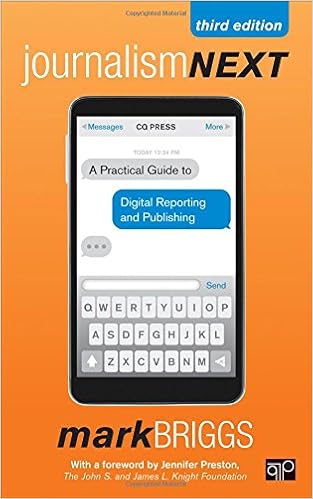(NOTE: The following series of posts is an excerpt from my upcoming book, Journalism Next, which will be published by CQPress and is due out in the fall.)
Can marketing and analytics save journalism? Not on their own, of course. But we live in a world where the amount of content produced has increased exponentially, yet we still each have just two eyes, two ears and one mouth. So journalism needs to find new benefits from new marketing strategies and measurement tactics.
This type of marketing is not advertising, or slogans, or logos. And this type of measurement isn’t counting bylines for a performance review. Digital publishers need to establish effective publishing goals and be consistent in their pursuit of those goals. Quality content published in some significant quantity and engineered to be easily found in search engines is a recipe for a successful digital publishing business.
“When a person conducts a search, you are competing against nine other results on that first result page,†Monica Wright wrote on the Search Engine Journal Web site. “Your title tag and description are your first impression to attract potential audience. You can capture new online readership by setting yourself apart with useful and engaging tags.
“But above all – good writing still prevails. Quality, relevant, in-depth content will not only attract the bots, but will capture new audience as well.â€
In order to build your audience online, you need to analyze what you publish, what your readers like and don’t like, and then do more of what they like. You also need to make sure that your content, especially that which your current readers have shown interest in, can be found by new audiences through search and shared through social media tools.
As newsrooms have taken on publishing new forms of content – blogs, video, breaking news updates – to new platforms – email, mobile, Twitter – new structures need to be put in place. Management guru Peter Drucker said years ago that “what gets measured gets managed.†In recent years, many have improved on that quote and say “what gets measured gets done.â€
So newsrooms now track and measure everything they do. At the News-Sentinel in Knoxville, for example, there is a detailed chart with everyone’s name listed down the left-most column and a long list of skills listed across the top. When someone can prove to a manager that he or she has mastered a new skill, the proper box is checked or, in some cases, a smiley face sticker is used to represent the progress.
Tom Chester, news operations manager at the News-Sentinel, begins each weekday with a stand-up meeting in the newsroom. The first item on the agenda is a detailed report of content published and traffic generated the previous day. “We track updates on all platforms: web, mobile, email,†Chester said. “We started with almost nothing and now we’re up to about 500 updates per week.â€
If newsroom leaders had simply announced at a staff meeting the need to learn new skills and publish more frequently to more platforms, little progress would have been made. Instead, the formerly print-centric newsroom – which has also published 3,000 videos since 2006 – has the structure in place to measure and manage the new content, the newsroom was able to show significant progress and build upon its successes.
Developing a culture and processes to track and measure your work product is essential to competing in this data-driven world. Traditional journalists may cringe at the idea that their artful storytelling or their dogged investigations can be reduced to a “work product,†but nearly all digital publishers are building their business on the inventory of content produced, either by journalists or other writers, bloggers or photographers. So producing that product on a regular schedule is vital to a functioning business.
And without the business, there are no paychecks. This reality applies to mainstream news companies and independent journalism startups.
Track. Measure. Adapt. It’s the way the Web works.
(If you have a creative or sophisticated system in place for tracking content and production, drop me a line. I can always use more practical examples for the book.)
Next: Part 2: Tracking what you publish
 Mark Briggs
Mark Briggs  Posted in
Posted in 





The police office in Tucson, Ariz. has released raw online video footage with the camera police officer Joel Mann was putting on when he brutally pummeled a woman pupil who was walking innocuously just off the campus of your University of Arizona.